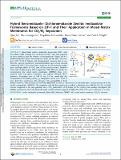Files in this item
Hybrid benzimidazole-dichloroimidazole zeolitic imidazolate frameworks based on ZIF-7 and their application in mixed matrix membranes for CO2/N2 separation
Item metadata
| dc.contributor.author | Jia, Qian | |
| dc.contributor.author | Lasseuguette, Elsa | |
| dc.contributor.author | Lozinska, Magdalena | |
| dc.contributor.author | Ferrari, Maria-Chiara | |
| dc.contributor.author | Wright, Paul A. | |
| dc.date.accessioned | 2022-10-05T16:30:06Z | |
| dc.date.available | 2022-10-05T16:30:06Z | |
| dc.date.issued | 2022-10-19 | |
| dc.identifier | 281277002 | |
| dc.identifier | 8a30a4a9-67e6-4298-a495-7ce1b7f243be | |
| dc.identifier | 85139570166 | |
| dc.identifier | 000870037000001 | |
| dc.identifier.citation | Jia , Q , Lasseuguette , E , Lozinska , M , Ferrari , M-C & Wright , P A 2022 , ' Hybrid benzimidazole-dichloroimidazole zeolitic imidazolate frameworks based on ZIF-7 and their application in mixed matrix membranes for CO 2 /N 2 separation ' , ACS Applied Materials & Interfaces , vol. 14 , no. 41 , pp. 46615-46626 . https://doi.org/10.1021/acsami.2c12908 | en |
| dc.identifier.issn | 1944-8244 | |
| dc.identifier.other | ORCID: /0000-0002-4243-9957/work/120434312 | |
| dc.identifier.uri | https://hdl.handle.net/10023/26141 | |
| dc.description | Funding: Q.J. acknowledges funding from the CSC scheme from the Chinese Government (201908140117). | en |
| dc.description.abstract | Mixed-linker zeolitic imidazolate frameworks (ZIFs) with the sodalite ( sod ) topology type and based on ZIF-7 have been prepared by direct synthesis from the mixtures of benzimidazole (BzIm) and 4,5-dichloroimidazole (dcIm). Incorporation of dcIm into the ZIF-7 structure gives ZIF-7/COK-17 hybrids with rhombohedral symmetry that do not show the “open-to-closed form” structural transition upon solvent removal exhibited by ZIF-7. They show Type I isotherms for low molecular weight gases and high affinity for CO2 even at low partial pressures. Synthesis under mild conditions gives ZIF nanoparticles (250–400 nm) suitable for incorporation into mixed matrix membranes (MMMs): these were prepared with both glassy (Matrimid) and rubbery (PEBAX 1657) polymers. Permeation tests at 298 K and 1.2 bar reveal that the incorporation of Zn(BzIm0.55dcIm0.45)2 nanoparticles at up to ca. 12 wt % gives defect-free membranes with enhanced CO2 permeability in both polymer matrices, with retention of selectivity (Matrimid) or with an enhancement in selectivity that is most pronounced for the smaller nanoparticles (PEBAX). The membrane with the best performance exhibits a selectivity of ca. 200 for CO2/N2 (a 4-fold increase compared to the pure polymer) and a CO2 permeability of 64 Barrer. At the relatively low loadings investigated, the MMMs’ performance obeys the Maxwell model, and the intrinsic property of diffusivity of the ZIFs can be extracted as a result. | |
| dc.format.extent | 12 | |
| dc.format.extent | 8664718 | |
| dc.language.iso | eng | |
| dc.relation.ispartof | ACS Applied Materials & Interfaces | en |
| dc.subject | Zeolitic imidazolate framework | en |
| dc.subject | Hybrid ZIFs | en |
| dc.subject | Matrimid | en |
| dc.subject | PEBAX 1657 | en |
| dc.subject | Mixed matrix membrane | en |
| dc.subject | CO2/N2 selectivity | en |
| dc.subject | QD Chemistry | en |
| dc.subject | DAS | en |
| dc.subject | MCC | en |
| dc.subject.lcc | QD | en |
| dc.title | Hybrid benzimidazole-dichloroimidazole zeolitic imidazolate frameworks based on ZIF-7 and their application in mixed matrix membranes for CO2/N2 separation | en |
| dc.type | Journal article | en |
| dc.contributor.institution | University of St Andrews. School of Chemistry | en |
| dc.contributor.institution | University of St Andrews. Institute of Behavioural and Neural Sciences | en |
| dc.contributor.institution | University of St Andrews. EaSTCHEM | en |
| dc.identifier.doi | 10.1021/acsami.2c12908 | |
| dc.description.status | Peer reviewed | en |
This item appears in the following Collection(s)
Items in the St Andrews Research Repository are protected by copyright, with all rights reserved, unless otherwise indicated.

